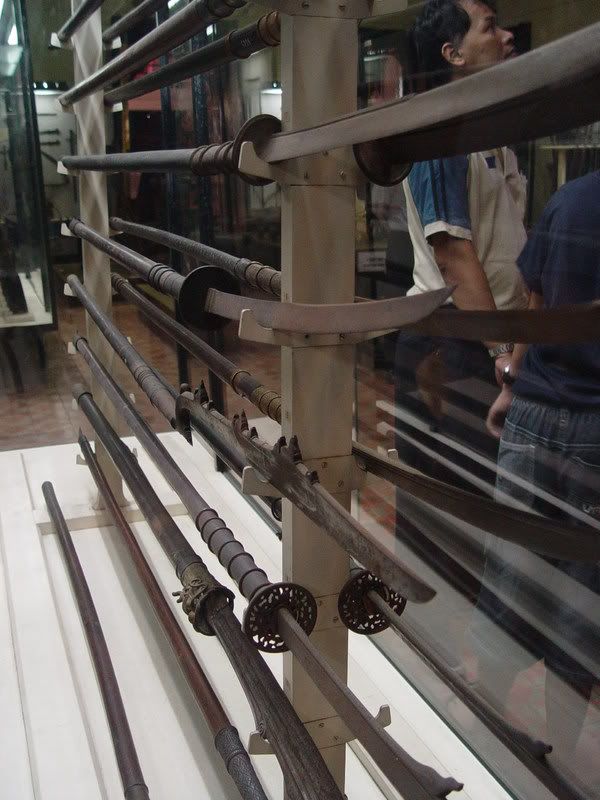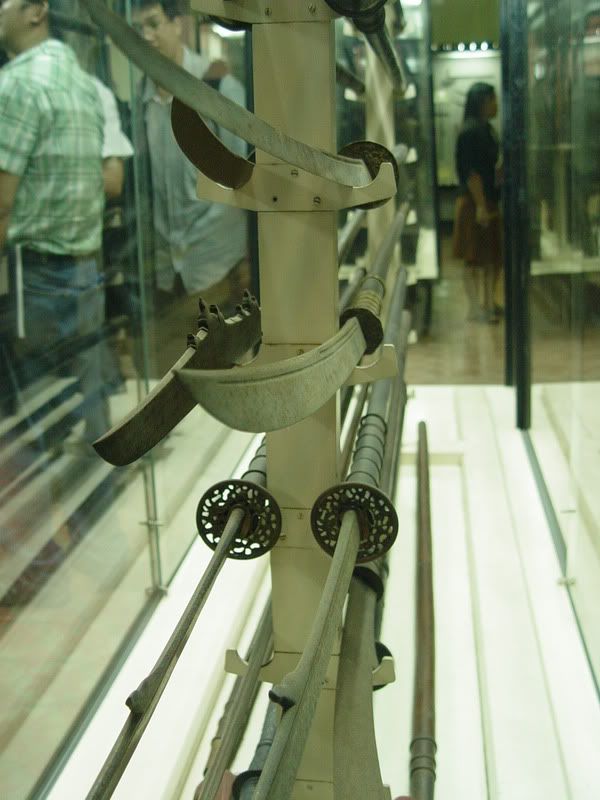
 |
|
|
|
|
#1 |
|
Member
Join Date: Nov 2004
Location: USA
Posts: 1,725
|
Ariel, you might consider contacting Philip Tom to attempt some forensic restoration on that sword. He may be able to remove the handle to examine the tang and polish a small window to get a good look at the blade construction.

|
|
|

|
|
|
#2 |
|
Member
Join Date: Dec 2004
Location: California
Posts: 1,036
|
In terms of overall form, the disc guard with oval lateral aperture as seen on Ariel's dha is something quite frequently encountered on some types of Vietnamese sabers. I think that the origin of the auxiliary apertures (there can be one or two) is definitely Japanese. As stated in Huard and Durand's CONNAISSANCE DU VIET-NAM (Hanoi: Ecole Francaise d'Extreme-Orient, 1954) p 155, there was a considerable import of Japanese swords into SE Asia in the 16th cent. Originally, the aperture(s) were to allow removal of the by-knife and skewer that are usually contained on the sides of Japanese scabbards. These accessories were not used on Vietnamese scabbards so the continued presence of the openings on locally-made versions of tsubas is for stylistic reasons only.
I have an example of a Vietnamese saber (guom) whose circular brass guard has two lateral openings. Recently I obtained several excavated bronze Vietnamese disc guards, reputedly obtained in the area of Hoi An, which boasted a resident Japanese merchant colony in the 16th-17th cent. (a covered bridge, and several graves, are extant testimonies to this community). One of the guards has a single D-shaped side opening, in this case too small to be of any functional use. Otherwise, the guard is multi-lobed with depictions of lions, dogs, and unicorns in relief, having a more Chinese flavor to the shape and art work. I have two others, both silver-inlaid copper, in which the apertures have morphed into S- and lozenge-shaped openings. Here, these also appear to be an original Japanese concept which has become modified with the strong Chinese elements which are integral parts of Vietnam's decorative arts. |
|
|

|
|
|
#3 |
|
Member
Join Date: Dec 2004
Location: Ann Arbor, MI
Posts: 5,503
|
So, Philip, what do you think: is it Cambodian or Vietnamese?
|
|
|

|
|
|
#4 |
|
Member
Join Date: Dec 2004
Location: California
Posts: 1,036
|
Ariel,
When I compare the guard on your sword with the loose bronze Vietnamese guards (the excavated ones) I have, I note the following. Your specimen is thinner, and without any flange or raised border around the rim. Some of the decorative motifs on yours bear some similarity to Vietnamese work, albeit in lower relief and with somewhat less precision. The shape of the oval aperture is spot on to those of other Vietnamese saber guards I've seen elsewhere. I am at a loss to explain the flaking or spalling to the surface of your specimen. In one of the pictures you posted, taken from the hilt side, I notice that a bit of the central mortise (for the blade) seems to extend beyond the periphery of the grip ferrule. I wonder if the guard is associated, and came from a hilt that originally had a wider blade. The frontal side shows some sort of dark brown fill surrounding the blade where it emerges from the guard. I'm wondering if this was put on to hold the guard steady on the tang, considering the apparent differential between the tang and mortise widths. From what I can see of the rest of the hilt (your photos are a bit dark), I don't see any typically Vietnamese design features. I doubt that guard and sword were "born together", and if the dha is Cambodian, it's possible that the guard may be an import from Vietnam, or a locally made copy thereof. |
|
|

|
|
|
#5 |
|
Member
Join Date: Dec 2004
Posts: 987
|
The details of the tsuba aside, it appears to me to be a fairly typical Cambodian dha. They tend to have disk-shaped guards, thinner, more evenly-tapered blades, and a distinctive "break" in the line of the curve of the blade and handle where handle meets blade.
|
|
|

|
|
|
#6 |
|
Member
Join Date: Feb 2006
Location: 30 miles north of Bangkok, 20 miles south of Ayuthaya, Thailand
Posts: 224
|
Here 's an example of Pae-Kak 's pole. Image from http://www.bladereview.com/forums/index.php?topic=3277
The pics were taken from The National Museum of Thailand, Bangkok.  
|
|
|

|
 |
|
|